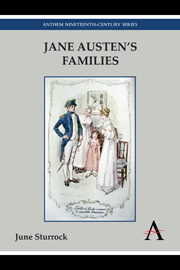Book contents
- Frontmatter
- Table of Contents
- Acknowledgements
- References and Abbreviations
- General Introduction
- Part I Family Dynamics
- Part II Fathers and Daughters
- Introduction
- Chapter Four Money, Morals and Mansfield Park
- Chapter Five Speech and Silence in Emma
- Chapter Six Dandies and Beauties: The Issue of Good Looks in Persuasion
- Conclusion: “Creative Attention”
- Notes
- Select Bibliography
- Index
Introduction
from Part II - Fathers and Daughters
- Frontmatter
- Table of Contents
- Acknowledgements
- References and Abbreviations
- General Introduction
- Part I Family Dynamics
- Part II Fathers and Daughters
- Introduction
- Chapter Four Money, Morals and Mansfield Park
- Chapter Five Speech and Silence in Emma
- Chapter Six Dandies and Beauties: The Issue of Good Looks in Persuasion
- Conclusion: “Creative Attention”
- Notes
- Select Bibliography
- Index
Summary
Both the nature of the relationship between father and daughter and the strong contrast between them are crucial in various ways in Austen's last four novels. Although Mr. Bennet is a careless father, Elizabeth and her father clearly love each other and continue to relish each other's company. Sir Thomas Bertram's absence is necessary for the plot of Mansfield Park, but the significance of his absence to his family, and especially his daughters, arises from the repression of his presence, so that Fanny Price's “habitual dread” (194) of him can only gradually develop into affection, as she becomes eventually “the daughter he wanted” (467). Mr. Woodhouse is in his way as poor a parent as Mr Bennet, but Emma Woodhouse, the most considerate of daughters, ends as she began, caring for him in his own home. Only in Persuasion is the relationship between father and daughter virtually loveless, and this lovelessness is significant in itself. As for the contrasts between father and daughter, in the three novels written at Chawton, Mansfield Park, Emma and Persuasion, Austen represents the father figure as a foil for its heroine in regard to issues that are central to the novel's ethical concerns. These strong contrasts between young women and older and more powerful men in the Chawton novels are the subject of Part II of this book.
- Type
- Chapter
- Information
- Jane Austen's Families , pp. 67 - 70Publisher: Anthem PressPrint publication year: 2013



